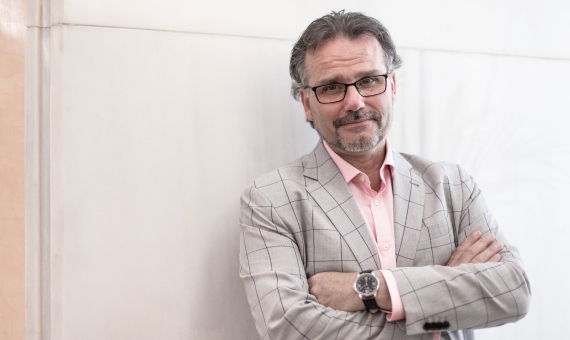Lucien Engelen is not afraid of Big Brother. In the future that he sees, a lot of which is already in the present, we are all monitored by and connected with our doctors. Our vital signs will be measured and instantly sent to health centers with which we will share medical responsibilities. As director of the Radboud REshape & Innovation Center, he works on the creation, development and implementation of innovations in healthcare. With these credentials he has participated in “Ch@nge: 19 Key Essays on How the Internet Is Changing Our Lives”, a book published by BBVA on the ways in which the Internet is transforming almost every aspect of our lives.

How can social media and technology make healthcare more sustainable?
The use of social media and technology in the next decade will have great benefits for healthcare. One of the main aspects is that of communication and the role of technology via the Internet or remote monitoring, which will allow us to take care of people in their own homes rather than from hospitals.
Why is it important for patients to take part in decisions that affect their health?
Imagine that your bank asked if you wanted it to give you your payment information, for example. That would seem obvious. Looking to healthcare, we believe that sharing information with patients, giving them their own information to improve their health, is not only a necessity but it should also be completely normal, and not just in healthcare. In recent centuries, the conversation between doctor and patient was very unequal because the patient had no information or data. This is now becoming more equal.
Gregorio Maranon said long ago that the best doctor was oneself. The discussion on the importance of the role of patients has been ongoing for ages. Could it be that the solution has to do with more than just technology?
It also has to do with technology because a century ago we created new technologies and new institutions, such as hospitals for example. Now we can bring that technology into the homes of people and also the patient is the expert on suffering from the disease. If we add this information to what the doctors already have, this will provide very beneficial results for everyone.
Could you provide a practical example of how social media and technology are helping us to improve our health?
I bought an electric scale four years ago. It’s a Wi-Fi scale connected to the Internet. When I step on this scale at 6 am, it sends my information to my website, but it also allows me to share the information in my social networks. I have 10,000 followers on Twitter and 300,000 on Linkedin, so every morning, shortly after jumping on my scale, I have people telling me that I should eat lightly today. This type of pressure from friends, for example, in a closed community could encourage people to lose weight or stop smoking or do something to treat an illness.
Secondly, I would like to point to this little patch that I have under my breast which allows me to send my vital statistics to my phone. Here is my pulse, my respiration rate, my body temperature and this information can be sent via the Internet to my colleagues in the Netherlands. With the use of technology that is available for a few hundred euros, we are basically doing the same thing as large systems that can cost tens of thousands of euros. This provides an opportunity to monitor patients at their homes or discharge them so they can return home earlier.
Ventana al Conocimiento (Knowledge Window)
Comments on this publication